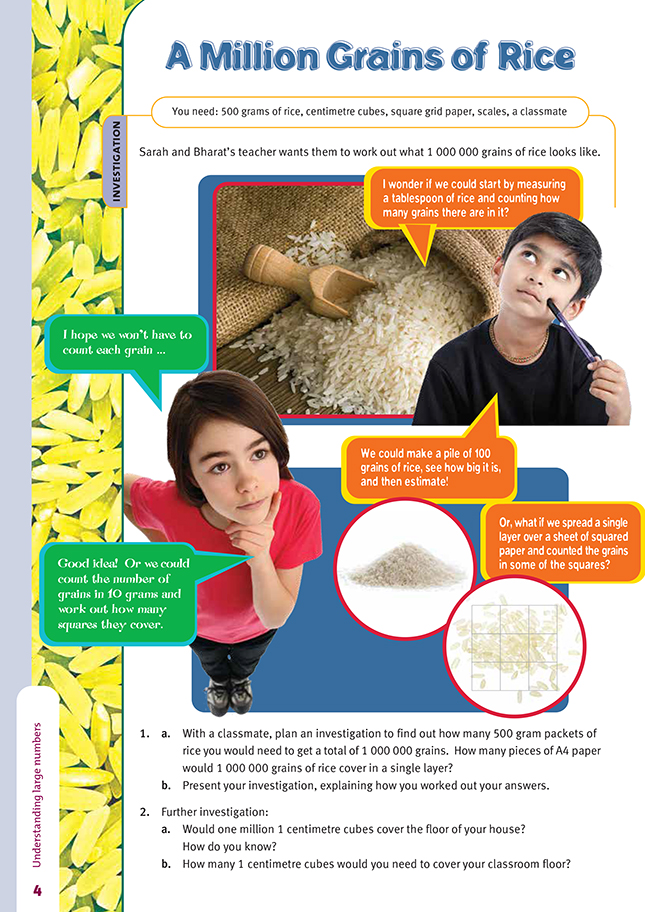This is a level 3 number link activity from the Figure It Out series.
A PDF of the student activity is included.
Click on the image to enlarge it. Click again to close. Download PDF (254 KB)
show understanding of large numbers
FIO, Link, Number, Book Two, A Million Grains of Rice, page 4
500g of rice, centimetre cubes, square grid paper, scales
A classmate
Explore with your students the relationships that exist between the place values of the digits in seven-digit numbers. Encourage them to make statements such as:
“The place value increases 10 times as we go one place to the left.”
“The place value increases 100 times as we go two places to the left.”
It would also be worthwhile to establish some key facts about what makes up a million. Questions such as “How many tens, hundreds, and/or thousands are there in one million?” would help to establish the necessary knowledge for the problems.
Ask the students to evaluate the problem-solving strategies suggested on the page. Two of the suggestions will result in the students seeing the million grains from a volume perspective, whereas the last suggestion will result in an area point of view. They could also explore a strategy for developing a linear view of the million grains. These strategies make this activity a wonderful opportunity for integrating number learning outcomes with measurement ones.
In question 1a, the students look at the mass and area of a million grains of rice. They use the 500 gram packet or the A4 sheet as one unit, and then they have to find out how many grains of rice are in this one unit. They then need to find out how many of the units are needed for one million grains of rice.
Encourage the students to use sensible factors when working out how many grains of rice are in the unit. For example, 10 x 50 = 500, so the students could weigh out 10 grams of rice, count the grains, and then multiply by 50 to find the number of grains in 500 grams. For the A4 sheet, the students could use fractions by folding the sheet into eighths, covering 1/8 of the sheet with grains, and then counting the grains and
multiplying the answer by 8.
Question 2 changes the item being worked with from rice to centimetre cubes. These cubes are used in an area context, so point out to the students that it is a square centimetre that is the issue here, not cubic centimetres. By using cm2, this question provides the opportunity to explore the connections between metric units of area, particularly that 10 000 cm2 = 1 m2. This fact can be expanded to show that a million cubes cover an area of 100 m2.
As an extension, the students could make a scale drawing of their house, cut the drawing up into separate rooms, and then see if they can rearrange all or some of the pieces into an area of 100m2.
Answers to Activity
Investigation
1. Results will vary.
2. a. Answers will vary. You will need to know the approximate area of your house. For a house that is 90 m2, you would need 900 000 cubes. A larger house would need more than a million cubes.
b. Answers will vary. You will need to measure your classroom. For a classroom with an area of 50 m2 you would need 500 000 cubes.
